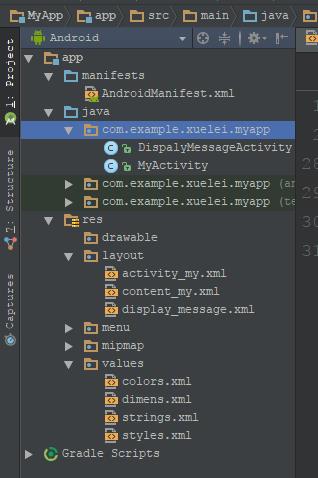安卓入门 使用android创建一个项目 从启动activity中响应按钮事件 启动另一个activity 并传递参数
Posted xuelei被占用了
tags:
篇首语:本文由小常识网(cha138.com)小编为大家整理,主要介绍了安卓入门 使用android创建一个项目 从启动activity中响应按钮事件 启动另一个activity 并传递参数相关的知识,希望对你有一定的参考价值。
启动android studio创建一个新项目
public void sendMessage(View view){
Intent intent=new Intent(this,DispalyMessageActivity.class);
EditText text =(EditText) findViewById(R.id.edit_message);
String message=text.getText().toString();
intent.putExtra(EXTRA_MESSAGE,message);
startActivity(intent);
}
添加按钮响应函数 sendMessage view中绑定的响应函数必须为公开无返回值 带有一个View参数的函数 通过View注入可以拿到View上的数据
Intent 对象常用语启动一个新的activity
findViewById 通过view中的id获取到控件对象 这与js获取input类似
通过getText 获取到输入框文本内容
intent.putExtra 将数据保存到intent对象中 这里EXTRA_MESSAGE 是当前类中定义的一个常量
startActivity用语启动一个activity
<?xml version="1.0" encoding="utf-8"?> <LinearLayout xmlns:android="http://schemas.android.com/apk/res/android" xmlns:app="http://schemas.android.com/apk/res-auto" xmlns:tools="http://schemas.android.com/tools" android:orientation="horizontal" android:layout_width="match_parent" android:layout_height="match_parent" app:layout_behavior="@string/appbar_scrolling_view_behavior" tools:showIn="@layout/activity_my" android:id="@+id/content"> <EditText android:layout_width="0dp" android:layout_weight="1" android:layout_height="wrap_content" android:hint="@string/edit_message" android:id="@+id/edit_message"/> <Button android:layout_width="wrap_content" android:layout_height="wrap_content" android:text="@string/button_message" android:onClick="sendMessage"/> </LinearLayout> <LinearLayout xmlns:android="http://schemas.android.com/apk/res/android" xmlns:app="http://schemas.android.com/apk/res-auto" xmlns:tools="http://schemas.android.com/tools" android:orientation="horizontal" android:layout_width="match_parent" android:layout_height="match_parent" app:layout_behavior="@string/appbar_scrolling_view_behavior" tools:showIn="@layout/activity_my" android:id="@+id/content"> <EditText android:layout_width="0dp" android:layout_weight="1" android:layout_height="wrap_content" android:hint="@string/edit_message" android:id="@+id/edit_message"/> <Button android:layout_width="wrap_content" android:layout_height="wrap_content" android:text="@string/button_message" android:onClick="sendMessage"/> </LinearLayout>

启动效果 这时点击send将跳转到一个新的activity
添加一个activity

在myactivity下添加一个class并且继承AppCompatActivity
重写 onCreate方法
protected void onCreate(Bundle savedInstanceState) {
super.onCreate(savedInstanceState);
setContentView(R.layout.display_message);
getSupportActionBar().setDisplayHomeAsUpEnabled(true);
Intent intent = getIntent();
String message = intent.getStringExtra(MyActivity.EXTRA_MESSAGE);
TextView textView = new TextView(this);
textView.setTextSize(80);
textView.setText(message);
textView.setWidth(100);
RelativeLayout layout = (RelativeLayout) findViewById(R.id.content);
layout.addView(textView);
}
这通过getIntent获取到intent对象
获取其中保存的message数据
创建一个TextView对象
通过id获取到View 并向该View动态添加一个textView空间
<?xml version="1.0" encoding="utf-8"?> <RelativeLayout xmlns:android="http://schemas.android.com/apk/res/android" android:id="@+id/content" android:layout_width="match_parent" android:layout_height="match_parent"> </RelativeLayout>
在AndroidManifest(清单)中注册该View
<?xml version="1.0" encoding="utf-8"?> <manifest xmlns:android="http://schemas.android.com/apk/res/android" package="com.example.xuelei.myapp"> <application android:allowBackup="true" android:icon="@mipmap/ic_launcher" android:label="@string/app_name" android:roundIcon="@mipmap/ic_launcher_round" android:supportsRtl="true" android:theme="@style/AppTheme"> <activity android:name=".MyActivity" android:label="@string/app_name" android:theme="@style/AppTheme.NoActionBar"> <intent-filter> <action android:name="android.intent.action.MAIN" /> <category android:name="android.intent.category.LAUNCHER" /> </intent-filter> </activity> <activity android:name="com.example.xuelei.myapp.DispalyMessageActivity" android:label="@string/title_activity_display_message" android:parentActivityName="com.example.xuelei.myapp.MyActivity" > <meta-data android:name="android.support.PARENT_ACTIVITY" android:value="com.example.xuelei.myapp.MyActivity"/> </activity> </application> </manifest>
添加一个activity name 该class的完全限定名 包名+类名
lable 设置该activity显示的lable名称
parentActivityName 指定父窗口对象 包名+类名
meta-data 这个名字值是额外的任意的可以提供给父组件的数据。一个组件元素能够包含任意数量的meta-data子元素。它们所有的值都会被收集在Bundle对象中并且使其可以作为组件的 PackageItemInfo.metaData 字段。
一般的值可以通过value属性来指定,但是如果要指定一个资源id作为一个值,那么就要用resource属性来代替。在这里用于获取 myactivity这个对象
这样就完成一个activity的跳转了
以上是关于安卓入门 使用android创建一个项目 从启动activity中响应按钮事件 启动另一个activity 并传递参数的主要内容,如果未能解决你的问题,请参考以下文章